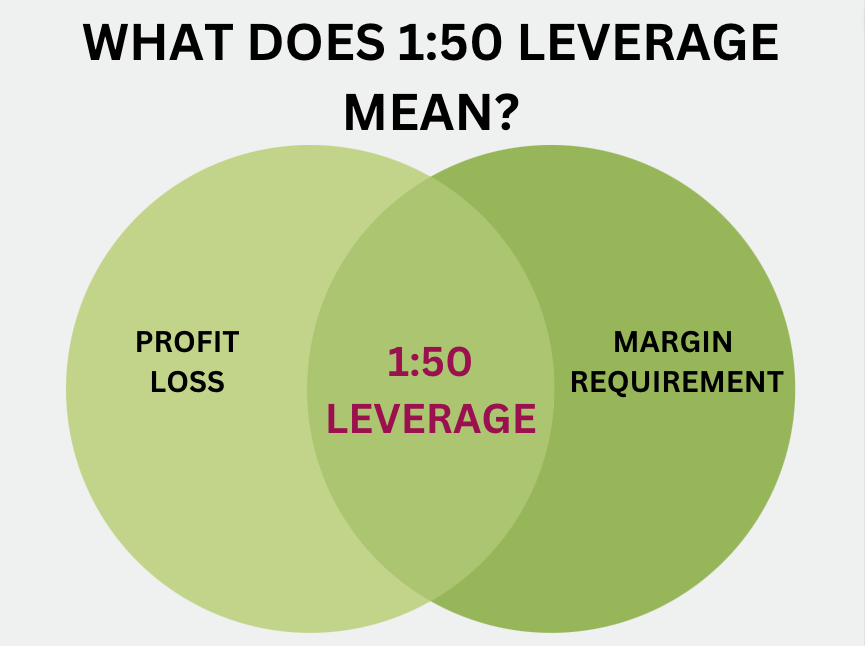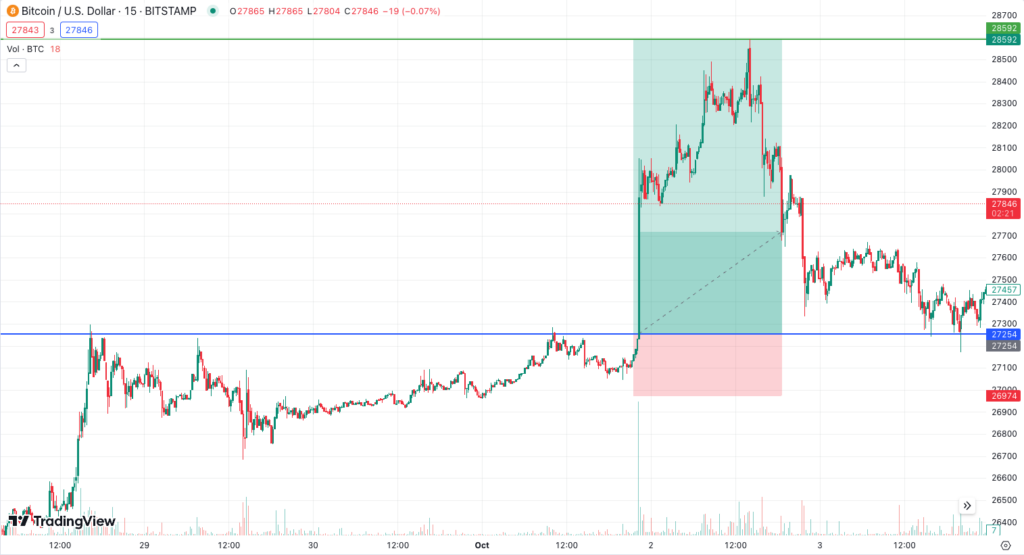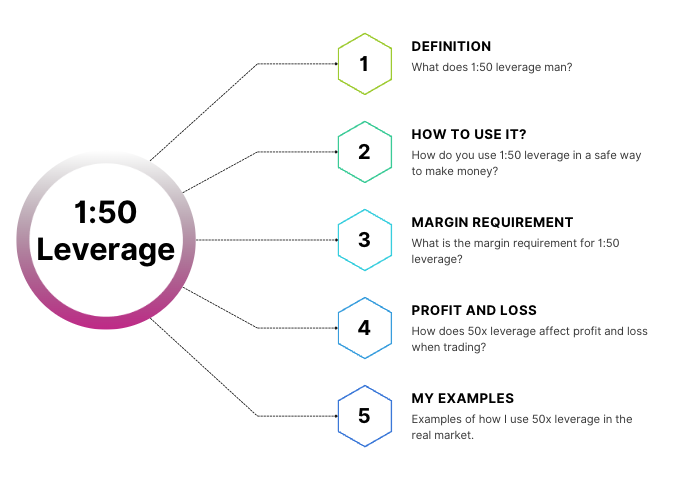In this article, we are going to break down 1:50, or 50x leverage, as it’s also called by many professionals.
What does it mean, is it good for beginners, and how much money can you make are some of the burning questions we found that we are going to answer today.
Perhaps you have already traded with this level of buying power, you maybe you just found out about this concept.
After reading this guide, you will have a better understanding of 1:50 and if it is good for you and your trading style.
Key takeaways
- 1:50 leverage offers trading with 50 times larger position sizes which greatly increases both profit and loss.
- The best way to use 50x leverage is to combine it with a good trading strategy, proper risk management, and choosing a reputable broker.
What does 1:50 leverage mean?

Trading the financial markets with 1:50 leverage means that you can control a position size that is 50 times larger than your initial deposit.
For every $1 in your trading account, you can now trade with $50.
For example, let’s say that you deposit $100 into your account and use 50x more money, this means that you can now trade with $5000.
Below is a table that demonstrates the effect of this ratio affects position size and your profit/loss:
| Initial Capital ($) | Leverage | Trading Position ($) | Potential Profit/Loss per 1 Pip Movement ($) |
|---|---|---|---|
| 100 | 1:50 | 5,000 | 0.5 |
| 500 | 1:50 | 25,000 | 2.5 |
| 1,000 | 1:50 | 50,000 | 5 |
How to use it
When using this amount of credit it is important to both use your best strategy and employ proper risk management.
Here is a step-by-step guide on how to start using 50x multiplier:
- Choose a broker: Select a broker that is regulated and offers the deposit methods of your choice. Make sure that the broker offers trading in your preferred market.
- Formulate your strategy: Before entering the market, select the strategy that you think is best suited for the current market environment.
- Use risk management techniques: Use a stop loss before you enter the market and if you can, try to use isolated margin which will drastically reduce your account risk.
- Assess your risk/reward ratio: When trading with high ratio it is important to choose your setups well seen from a risk/reward ratio perspective. As a general rule of thumb, a risk/reward ratio of 1:3 should be a minimum to stay profitable, although it is not a guaranteed way of making money. Use our risk reward ratio calculator to figure out your risk/reward ratio.
- Choose position size: Selecting position size is very important and you should always opt to follow the 1% rule which means that you don’t risk more than 1% per trade. Use our leverage calculator to find out your ideal position size.
- Place your order: Before placing your order, double-check that the ratio is correct and check your stop-loss levels.
Although 1:50 is not the maximum leverage in forex, it is still a high ratio to use for beginners.
Take all the precautions you can before entering the markets, especially if you are a beginner.
What is the margin requirement for this ratio?
The margin requirement for trading with 1:50 leverage is 2% and does not change even when you change the position size.
Margin Requirement = (1 / Leverage) x 100
So, if you’re using 50x (or 1:50):
Margin Requirement = (1 / 50) x 100 = 2%
To explain further how the margin requirement works when trading with a multiplier, take a look at the table below:
| Leverage | Margin Requirement ($) for $10,000 Trade | Margin Requirement (%) |
|---|---|---|
| 1:1 | $10,000 | 100% |
| 1:10 | $1,000 | 10% |
| 1:50 | $200 | 2% |
| 1:100 | $100 | 1% |
| 1:200 | $50 | 0.5% |
| 1:500 | $20 | 0.2% |
Things to keep
in mind about lot sizes
You must understand the relationship between lot size and leverage to select the correct position size for your risk tolerance.
When a trader uses 1:50 more purchasing power, it means that they can control a lot size that is 50x larger than their account size.
This means that for every $1000 deposited, the trader can control $50.000.
In forex, a “lot” is the standard way of measuring the position sizes:
- Standard lot: 100,000 units of the base currency
- Mini lot: 10,000 units
- Micro lot: 1,000 units
- Nano lot: 100 units
Let’s say that you want to trade 1 standard lot of the forex pair USD/GBP which is the same as trading 100,000 units worth of USD.
If the exchange rate of USD/GBP is 1.10 USD for every GBP, then you would need to deposit $110,000 to open the position.
Now, with a ratio of 1:50, things change.
With this amount of money, you would only need to deposit 1/50 of the real position size which equals $2,200.
As you can see, the added capital shrinks the margin requirement and lets you trade a larger position size with less cash.
How it compares to other ratios
Let’s look at four different ratios and how they compare against 50x.
1. No (1:1)
Your profit potential is lowered, your risk is reduced, and you are limited to your trading capital.
- Margin requirement: Limited to the trader’s own capital.
- Risk: Losses cannot exceed the invested capital.
- Profit potential: Lower compared to leveraged trading.
- Best suited for: Risk-averse traders and long-term investments.
2. Low (1:2)
You can control twice as much money, your risk is doubled, and your profit potential is two times higher.
- Margin requirement: Each dollar controls $2 in the market.
- Risk: Moderately higher than the spot market assets, but still low.
- Profit potential: Low but twice as much as spot markets.
- Best suited for: Beginner traders seeking a balance between risk and return.
3. Medium (1:50)
You now control $50 per invested dollar, your risk is outsized, and your profit potential is much larger.
- Margin requirement: Each dollar controls $50 in the market, increasing the trade size drastically.
- Risk: Much higher, losses can grow fast.
- Profit potential: Very high.
- Best Suited for: Experienced traders with a robust risk management strategy.
4. High (1:100)
You trade with 100 times larger position sizes, the risk is extremely high, and your profit potential is greatly increased.
- Margin requirement: $1 controls $100 in the market.
- Risk: Highly elevated, losses can be surprisingly large.
- Profit potential: Extremely high.
- Best suited for: Highly experienced traders, willing to accept the high risk.
Examples of how I use this ratio
Now, when I trade with a high ratio I always make sure to think about three things in particular:
- Risk
- Trade setup
- Profit potential
The way I see risk is how likely is the market to come back and stop me out after my entry.
I always make sure to take trades that are favorable for me when it comes to timing and risk/reward ratio.
If a setup looks good timing-wise but it doesn’t look good from a risk/reward perspective, I never take the trade, both things have to line up.
Take a look at this trade, it has perfect timing and the risk/reward ratio is greatly in my favor:

The stop loss level was -1.03% below the entry and the take profit level was +4.91% above the entry.
The stop loss level is within the liquidation price range which tells you that there is no way for you to get liquidated even when using 1:50 leverage.
Use our liquidation price calculator to make sure that your trade is in the safe zone.
The timing was great because the market was slowly trending higher and it broke a previous resistance zone with a tripple top formation which is a strong breakout scenario if the tripple top fails.
The trade was accompanied by high volume straight after the market pushed above the last high which is a good sign.
Where to find this kind of ratio
Depending on the leveraged product you are trading several platforms offer this kind of margin level.
Forex brokers systematically offer high multipliers.
Avatrade, Etoro, and Pepperstone are some of the most reputable names in the industry.
Spread betting brokers also offer 50x more money and in some cases up to 1000x.
Some of the most popular brokers in financial spread betting today are City Index, IG, and SpreadEx.
Other top CFD brokers that typically offer ratios above 1:200 are CMC Markets, Forex.com, and XTB.
Remember to do your own research about each platform before signing up and depositing real money.
Each platform has something different to offer and all of them might not be for you.
How it affects profits and losses
To show you the effect that leverage has on profits, especially when using 1:50, I’ve created a table to demonstrate:
| Initial Capital ($) | Leverage | Trade Size ($) | Price Movement (%) | Profit/Loss | |
|---|---|---|---|---|---|
| Without Leverage ($) | With 1:50 Leverage ($) | ||||
| 1000 | 1:50 | 50000 | +5 | +50 | +2500 |
| 1000 | 1:50 | 50000 | -5 | -50 | -2500 |
| 2000 | 1:50 | 100000 | +3 | +60 | +3000 |
| 2000 | 1:50 | 100000 | -3 | -60 | -3000 |
As seen in the table, a position size of $1000 when trading without leverage only yields a $5 profit.
However, with a ratio of 1:50, the same position can earn $2500 with the same market movement.
Pros and cons
In this section, I thought I would write down the most significant pros and cons.
Pros
- Increased profits: Your profits have increased 50 times. On a trade where you would normally profit $12, you know make a $600 profit.
- Trading more markets: CFD brokers offer a huge variety of trading products. You can trade indices, stocks, ETFs, crypto, Forex, and precious metals from one single interface.
- Option to hedge: This goes for all types of margin-based trading but the option to hedge your positions is a great tool that will help you reduce risk during highly volatile periods.
- Making money scalping: Making money in short-term trading is very difficult since you are dependent on large volumes to make a profit. It becomes easier since the payout per point is much larger.
Cons
- Amplified losses: The risk of loss is greatly increased when trading with leverage, especially with 50x. On a trade where you would normally lose $5, you would now lose $250. Be cautious of the loss potential.
- Fast losses: Not only do the losses get bigger, but they amount much faster. The loss per pip or loss per point might surprise you when you first attempt to trade with borrowed capital.
- Complex: Margin adds complexity to trading that you need to adjust to before putting real capital to use. Learn the ins and outs and make sure you learn how to change the leverage on MT4 or your chosen trading platform before you start.
- Increased trading costs: Leveraged trading commissions scale linearly with the ratio you have chosen. Your fees are also increased 50 times. On a trade where you normally would pay $0.20 per trade, you now have to pay $10.
Final words
Is 50x leverage a good idea for beginners? Let’s break it down. A 1:50 multiplier can help you trade larger position sizes than you normally would without margin which will increase your profit potential.
However, this potential swings both ways and also increases the potential for loss to the same amount. For beginners, it is recommended to start with a lower ratio, perhaps 1:2, 1:5, or 1:10 to stay on the safe side.
Should you still be interested in trying higher ratios you can always opt for a demo account and start in a risk-free environment. Then, when you have gained more experience you can slowly progress to the live market with a smaller stake.
Remember, risk management and trading strategies are the two most important factors in any successful leverage trading plan.


